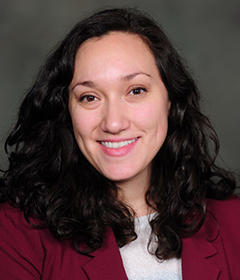April 19, 2022
Former NIEHS-funded trainee Tiffany Sanchez, Ph.D., is now an assistant professor committed to identifying strategies to prevent arsenic-related diseases.

Tiffany Sanchez, Ph.D., a former NIEHS-funded trainee at the Columbia University Superfund Research Program (SRP) Center, aims to understand connections between metal exposures and disease in order to identify prevention strategies.
Sanchez, an expert in exposure analysis, multidisciplinary and translational research, and data science, is now an assistant professor at Columbia.
Finding a Niche
Sanchez became interested in environmental exposures when she was attending high school in Albuquerque, New Mexico. During that time, she worked with a plastic surgeon who was reconstructing children’s cleft lips and palates – birth defects that occur when the lip or mouth don’t form properly while a baby is developing in the womb.
“This work was primarily with children living in Native American reservations exposed to metals and other contaminants, and it sparked my interest in understanding how environmental exposures before birth can have lasting health consequences.” Sanchez shared. “If we can understand how these exposures affect health, maybe we can prevent harmful outcomes from happening.”
Sanchez has been involved with the Columbia SRP Center since she was an undergraduate student. While pursuing her bachelor’s degree, she worked with former center director Joe Graziano, Ph.D., to understand children’s exposure to metals.
“Working with Dr. Graziano helped me to find a group of people who were considering the same questions I had always been wondering about,” Sanchez reflected. “That’s when I realized I was meant to be an environmental health scientist.”
Working With Large Cohorts
Sanchez’s work often entails parsing data from long-term studies involving large cohorts, or groups, of participants.
For example, as a doctoral student mentored by Graziano, Sanchez used data from the Health Effects of Arsenic Longitudinal Study – a long-term study in Bangladesh – to understand the connections between environmental exposures and health. For over 20 years, HEALS has been a landmark research resource for uncovering the links between arsenic exposure and various health effects.
Sanchez and team observed that mixtures of arsenic and other metals may play a role in disease development in participants. They found that arsenic and cadmium exposure via drinking water may negatively affect neurodevelopment and intellectual function in adolescents.
For her postdoctoral research, Sanchez worked with current center director Ana Navas-Acien, Ph.D. Her work examined associations between adults’ exposure to arsenic through diet — specifically rice — and later health problems, such as such as cardiovascular disease and cancer.
While working with Navas-Acien, Sanchez conducted research using data from several cohorts, including the California Teachers Study, the Multi-Ethnic Study of Atherosclerosis, and the Strong Heart Study.
Using data from the MESA cohort, Sanchez and team found differences in arsenic exposure by geographical region and by ethnicity in the U.S. population.
“All of these studies took place in the U.S., but each population had different types and sources of exposure,” Sanchez said. “It's important to understand differences in exposure profiles and how they might affect disease development and risk.”
More recently, Sanchez and collaborators at Columbia used data from the Strong Heart Study and found that arsenic and uranium may interact and contribute to the development of diabetes in Native Americans. The researchers observed that the metals affected processes associated with the metabolism of energy, fatty acids, and amino acids. They suggest that future studies should investigate the relationship between metals, metabolism, and pathways of disease.
Passing Down Lessons
As an assistant professor at Columbia, Sanchez is also interested in integrating data science into the environmental health sciences’ curriculum. She launched a Data Science for Environmental Health course and is working with other faculty at Columbia to create a master’s program in environmental health data science. Through these efforts, Sanchez is helping environmental health students become more comfortable with number crunching and more engaged with data science.
“Environmental health scientists work with so many different types of data from diverse sources,” said Sanchez. “We have to be able to understand and work with diverse data so we can actually do something useful with it.”
Sanchez is passionate about mentoring her students and passing on the knowledge she gained from her own advisors.
“I would not be the researcher I am today without the mentorship I received as a trainee,” Sanchez reflected. “Dr. Graziano helped me understand my potential as a scientist and opened my eyes to what a career in environmental health could be. And Dr. Navas-Acien gave me the skills and the ability to pivot myself into becoming an independent researcher.”
“Mentoring students across the academic pipeline, including undergraduate and graduate students, is one of the best parts of my job,” Sanchez explained. “I get excitement from working with young researchers and seeing them become passionate about environmental health, just like I did.”


